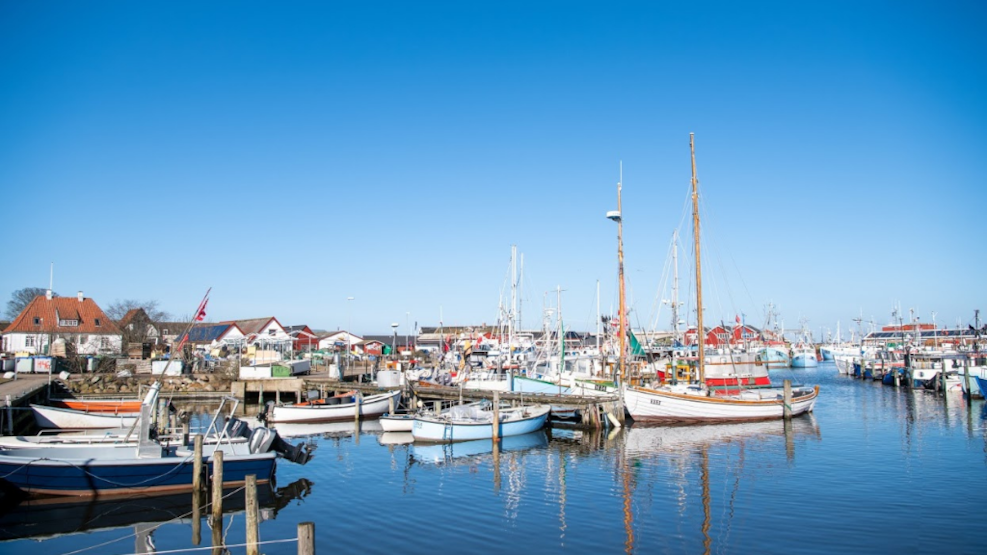
© Photo:
Historical Treasure Hunt on your own in Gilleleje
Museum North Zealand welcomes you to a historical quest in Gilleleje Harbour and Fishing Village. The treasure hunt is an offer specifically designed for families with children, but everyone is, of course, welcome!
The self-guided tour begins at the harbour basin north of Gilleleje Fish Auction, Auktionskajen 1, Gilleleje. Download the sheet you need to fill out.
How do I hunt?
- The brochure has six small stories with maritime content and related questions – and a map. Please write your answers below.
- The walk starts by the harbour basin north of Gilleleje Fish Auction (1 Auktionskajen)
- You complete the tasks by considering the questions and what you see and perhaps getting help from the adults and/or your phone.
- Remember that a harbour is often hectic with people working – so show caution.
- The hunt ends at Skibshallerne. (opening hours at museumns.dk) You will have free entry to the museum by answering all the questions in writing and handing the brochure to the staff.
- If all answers are correct, you receive a small prize.
- The harbour basin is north of the auction house. The former filleting factory is located west of here. Unfortunately, it had to shut down recently due to decreased landings. At the filleting factory, they would process herring, which is essential to the Kattegat fisheries. Today, catching fish is still important, but not as much as catching one type of shellfish: the Norwegian lobster. It is also called “deep water lobster” because it lives on the seabed much larger than the giant common lobster. Can you mention two other types of fish vital to the local fishing trade?
- You can see the fishing boats and the auction house where today’s catch is being sold as soon as the fishermen have landed the fish. Take a walk and look at the fishing boats. There are different ways of catching fish (and shellfish). The fishermen might use fixed gill nets or drag a sizeable conical net widened by iron plates behind the boat (trawling). How can you see whether the various boats live off-net fishing or trawl fishing? Can you mention one or two other methods of fishing?
- Look at the large stone jetties protecting the harbour. Many stone reefs are scattered around Kattegat, essential habitats for various species. The so-called stone fishermen made money by fishing huge stones from the reefs used to build jetties. Some of the reefs disappeared entirely. What do you think people do today? Do they still fish out large quantities of stones from the sea, or do they find boulders inland and dump them into the sea in huge numbers? By the way, can you mention a type of giant, delicious shellfish that prefers nesting at the stone reefs?
- Vilhelm. Take a closer look at this fine-looking fishing boat from 1888. The hull is made of horizontal planks called “boards”, which is why you “board” a ship or are “on board”. Below the deck, the boards are supported across by frames fastened to the keel. The mast is supported by ropes, shrouds to the side and stays fore and aft. The front stay is on a bowsprit that juts out over the ship's bow. This is where you set the front sail. The left side of the ship is called the port side. Do you know what the right side is called – and why?
- Toldstedet (The customs office) 5 Ndr. After Gilleleje Harbour was finished in 1873, more and more ships arrived carrying goods – also foreign ships. For this reason, the town needed a place where foreign goods like coal and timber would be registered (“declared”) and where the foreign ships would pay customs (Danish told) to the Danish state. Initially, this was a rented house, and in 1928, this pillared customs office was built. Do you know what the Danes call a customs office like this found in many Danish ports? There is a somewhat similar word in English.
- The boatyard, seen from the marina. Look due west to see the area where the ships await repairs at the boatyard. The yard here in Gilleleje was established back in 1850. At that time, they would use the beach by the eastern pier with its shallow water to pull the boats up so that the hull could be overhauled. What do you call the act of pulling the boats onto the beach to be overhauled?
- Welcome to Skibshallerne (20 Østergade) – the Fisheries and Coastal Culture Exhibition. This is where your walk ends, and you can determine whether your answers are correct. You might enjoy the museum’s exhibition on fisheries and life by the sea as it was in the old days. On display is also an exhibition of October 1943, when the fishermen of Gilleleje helped Danish Jews escape to Sweden. You can also relax in the museum’s cosy garden café.